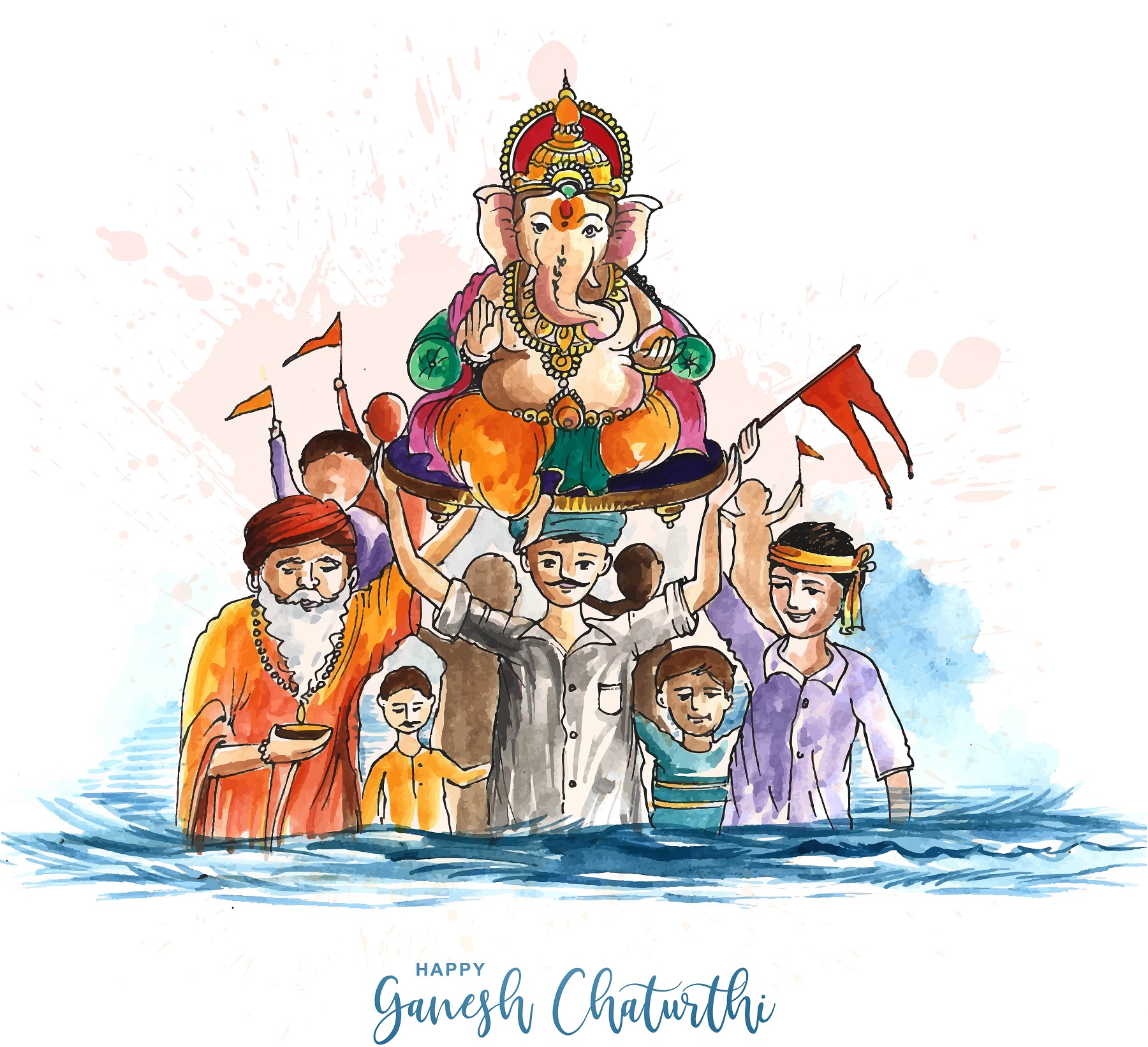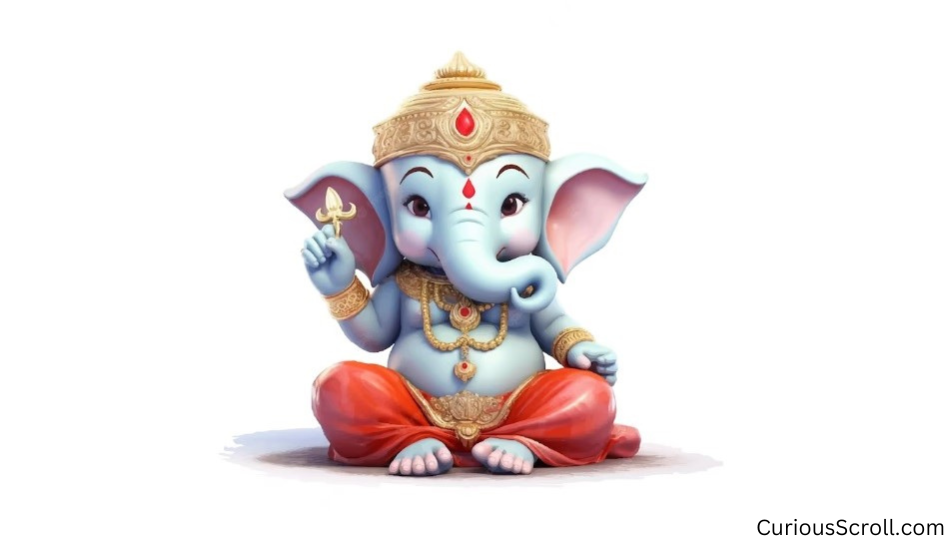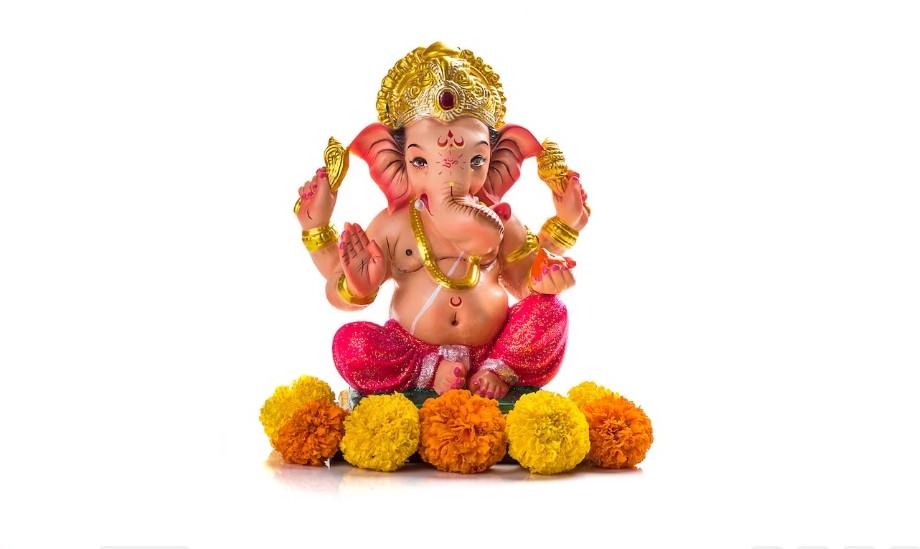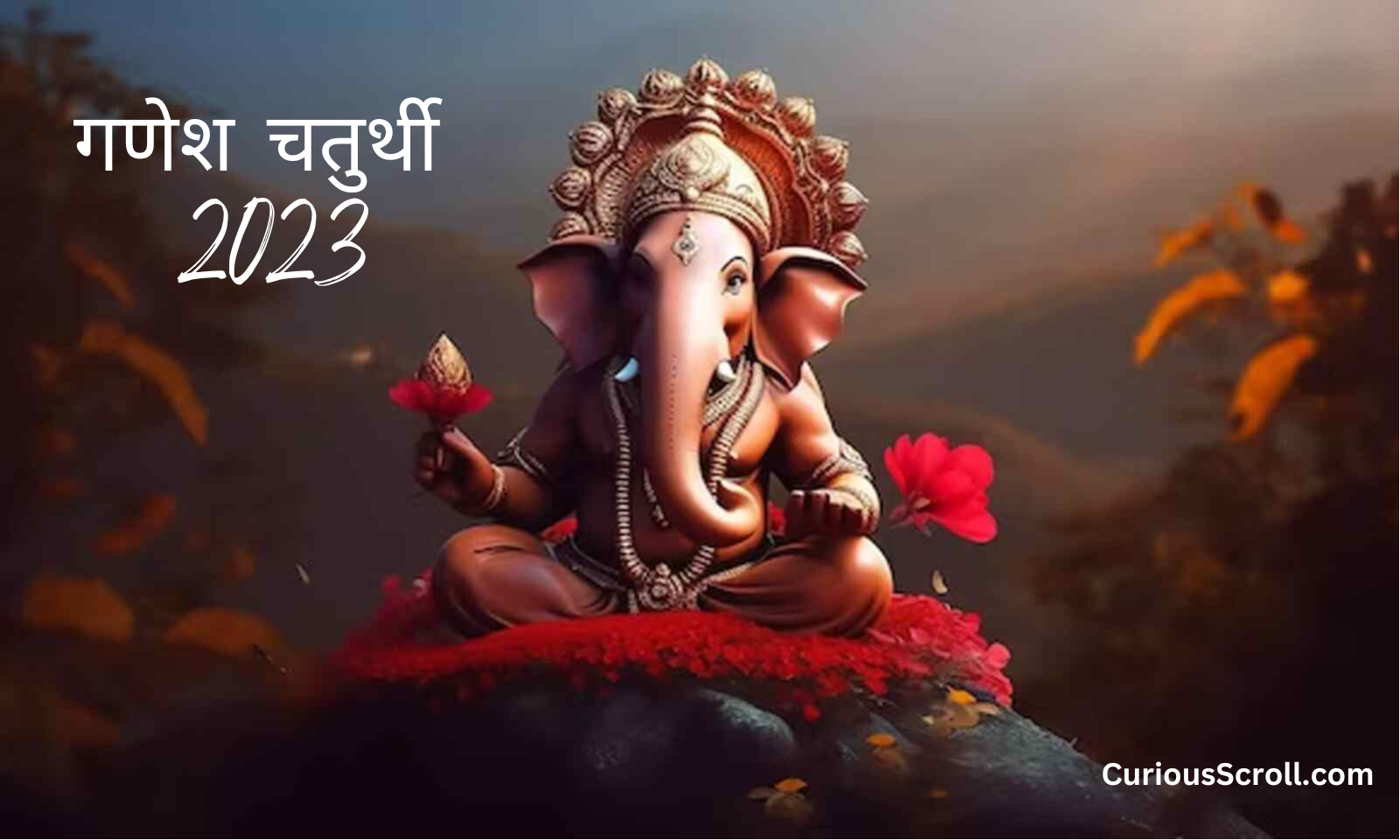Hindus commemorate Lord Ganesha, the elephant-headed god,’s birth on Ganesh Chaturthi. This year, the festival will commence on September 19, 2023, and will last for 10 days. Ganesh Chaturthi 2023 information is provided below:
Date and Time
- On Tuesday, 19 September, 2023, Ganesh Chaturthi will be celebrated.
- The Ganesh Chaturthi Tithi will start on 18 September, 2023, at 12:39 PM and end on 19 September, 2023, at 01:43 PM.
- Ganesh Visarjan will be observed on the 10th day, which falls on Thursday, September 28, 2023.

Rituals
- Ganesha statues are brought home and are worshipped for 10 days.
- Flowers and other ornaments have been used to embellish the idol.
- People who worship Lord Ganesha present him with sweets, fruits, and other delights.
- On the 10th day, the idol is taken out in a grand procession and immersed in a nearby water body.
Importance
- The holiday of Ganesh Chaturthi commemorates the birth of Lord Ganesha, who is revered as a god of intellect and knowledge as well as the remover of barriers.
- All across India, especially in Maharashtra, where it is the most significant event of the year, the festival is observed with tremendous zeal and fervour.
Latest Update
The Hindu calendar states that Vinayak Chaturdashi 2023 will begin on Monday, September 18, at 12:39 PM, and finish on Tuesday, September 19, at 8:43 PM.
Ganesh chaturthi 2023: Start & end date
The search results indicate that Ganesh Chaturthi will begin and conclude on these dates in 2023:
Start date: Monday, September 18, 2023, at 12:39 PM
End date: Wednesday, September 28, 2023
The immersion of Lord Ganesha’s statue will take place on Anant Chaturdashi, which falls on September 28, 2023, and the celebration will continue a total of 10 days. It’s crucial to remember that the times and dates might change based on where you are and what time zone you’re in.
How many days does Ganesh Chaturthi last
Ten days are dedicated to Ganesh Chaturthi. The festival starts on the fourth day (chaturthi) of the Hindu month of Bhadrapada (August-September), which is the day of Lord Ganesha’s birth. On Anant Chaturdashi, often referred to as Ganesh Visarjan Day, the celebration comes to a close. After a grand street parade on this day, worshippers submerge the Ganesha statue in a body of water.
Ganesh chaturthi 2023: Visarjan date
The Ganesh Chaturthi 2023 Visarjan date is Thursday, September 28, 2023. This is the day of Anant Chaturdashi, which is the most significant day for performing Ganesha Visarjan. The third, fifth, or seventh day after Ganesh Chaturthi may be preferred by some households. It’s crucial to remember that the times and dates might change based on where you are and what time zone you’re in.

Significance of Ganesh Chaturthi in Hindu mythology
Ganesh Chaturthi is a significant festival in Hindu mythology, celebrating the birth of the elephant-headed deity Ganesha, the god of prosperity, wisdom, and the remover of obstacles. The event is significant in terms of both religion and culture in the following ways:
- Birth of Lord Ganesha: On the day of Ganesh Chaturthi, Lord Ganesha was sculpted from clay by Goddess Durga, who subsequently gave the idol life. He was chosen to serve as the protector of their home’s entrance and was born to Lord Shiva and Goddess Parvati.
- Remover of Obstacles: The deity of fresh beginnings, intellect, and removing barriers is known as Lord Ganesha. Before beginning every new project, academic quest, or economic venture, people worship him and ask for his blessings for success and the elimination of barriers.
- Cycle of Birth, Life, and Death: The importance of the cycle of birth, life, and death is also symbolised by the Ganesh Chaturthi festival. It is said that when the Ganesha statue is removed from the home for the immersion, all of the house’s numerous barriers are also removed with it.
- Public Celebration: When Maratha king Shivaji utilised Ganesh Chaturthi to incite his followers to support nationalist fervour in their war against the Mughals, the festival came to resemble a grand public celebration. Freedom warrior Bal Gangadhar Tilak brought back the event in the 19th century as a representation of the Indian independence effort. Despite the British ban on political assemblies in 1893, the festival was celebrated with patriotic gusto, showcasing the unity and resilience of the Indian people.
Clay statues of Lord Ganesha are erected both publicly on magnificent pandals (temporary stages) and privately in residences during the festival. Vedic chants, Hindu literature, prayers, and fasting are among the customs observed. Devotees offer coconut, jaggery, and 21 modaks (sweet dumplings), which are considered to be Lord Ganesha’s favorite food.
Lord Ganesha’s birth according to Hindu mythology
The following is the mythological account of Lord Ganesha’s birth in Hinduism:
- Creation by Goddess Parvati: Lord Ganesha was born from clay and produced by Goddess Parvati, the husband of Lord Shiva. She created him to guard her while she bathed. While she was taking a bath, she gave him the order to bar entry to the house.
- Beheading by Lord Shiva: When Lord Shiva returned home and tried to enter the house, Lord Ganesha stopped him, as he did not recognize him as his father. Lord Shiva, who had no idea who Lord Ganesha was, was furious and, in a fit of wrath, hacked off his head.
- Replacement of Head: When Goddess Parvati learned about the incident, she was devastated and asked Lord Shiva to bring Lord Ganesha back to life. Lord Shiva then ordered his followers to bring him the head of the first living being they encountered. The elephant’s head was brought to him, and Lord Shiva joined it to Lord Ganesha’s body to give him his distinctive look.
- Blessings by the Gods: Because of Lord Ganesha’s distinctive looks and his love for his mother, the gods were moved and bestowed upon him several favours. Additionally, they proclaimed that Lord Ganesha would be worshipped before anybody else at the start of any rite, regardless of the situation. A master of intelligence and understanding was also bestowed upon him.
Lord Ganesha’s birth is celebrated as Ganesh Chaturthi, which is a significant festival in Hinduism. Beginning on the fourth day (chaturthi) of Bhadrapada (August–September), the sixth month of the Hindu calendar, the festival is observed for ten days. Clay statues of Lord Ganesha are erected both publicly on magnificent pandals (temporary stages) and privately in residences during the festival.

The Lord Ganesha’s elephant head’s significance
The elephant head of Lord Ganesha is a significant aspect of his mythology and symbolism. There are several Puranic stories about Lord Ganesha and his elephant head, which are as follows:
- Parvati’s Creation: According to one story, Parvati, Lord Shiva’s wife, created an image of a child with an elephant’s head out of the unguents smeared over her body and threw it into the river Ganga. As soon as the picture came to life, Ganga and Parvati acknowledged the youngster as their son. Since he has two moms, Lord Ganesha is also known as Dvaimatura.
- Lord Shiva’s Anger: Another legend claims that Lord Shiva severed Lord Ganesha’s head when he forbade him from going inside his own home. When Lord Shiva came back, Lord Ganesha stopped him, since he had been created by Parvati to protect her while she took a bath. Lord Shiva grew enraged and severed his son’s head after failing to recognise his own son. Later, when he realized his mistake, he replaced Lord Ganesha’s head with that of an elephant.
- Symbolism: The elephant head of Lord Ganesha is a representation of a number of traits, including power, intellect, and wisdom. The elephant is regarded as a luck and wealth sign as well. Lord Ganesha’s elephant head is also believed to represent the idea of overcoming obstacles, as elephants are known for their strength and ability to overcome obstacles.
- Mythology: Lord Shiva and Goddess Parvati are the parents of Lord Ganesha. His elephant head is said to have been given to him by Lord Shiva as a replacement for his original head, which was cut off by Lord Shiva himself. As the deity of fresh starts, wisdom, and the removal of barriers, Lord Ganesha is revered.
In Hindu mythology, Lord Ganesha is one of the most popular and revered deities. His elephant head is an important aspect of his mythology and symbolism, representing wisdom, intelligence, strength, and the ability to overcome obstacles.
Story behind Lord Shiva cutting off Ganesha’s head
According to Hindu mythology, there are several stories behind Lord Shiva cutting off Lord Ganesha’s head. These are a few of the well-known tales:
- Ganesha’s Refusal: According to one of the legends, Goddess Parvati created Lord Ganesha as her personal watchdog as she showered. When Lord Shiva returned, he was stopped by Lord Ganesha, who did not recognize him as his father. Lord Shiva, who was unaware of Lord Ganesha’s identity, became angry and cut off his head in a fit of rage.
- Arrogance of Ganesha: Another story suggests that Lord Ganesha was being arrogant and needed to be cleansed of his impurities from birth. Lord Shiva decided to do the cleansing by taking the source of impurities, which was Lord Ganesha’s head.
- Divine Fury: According to another story, Lord Ganesha was created by Goddess Parvati out of clay and brought to life. When Lord Shiva returned home, he found Lord Ganesha guarding the entrance and preventing him from entering. Seeing that this was no ordinary boy, Lord Shiva decided to fight him, and in his divine fury, he severed Lord Ganesha’s head.
Regardless of the story, Lord Shiva later realized his mistake and replaced Lord Ganesha’s head with that of an elephant. This act is believed to have given Lord Ganesha his unique appearance and made him one of the most popular and revered deities in Hindu mythology.

Significance of Anant Chaturdashi in Ganesh Chaturthi
Anant Chaturdashi is a festival that is celebrated on the fourteenth day of the waxing phase of the moon during the Hindu month of Bhadrapada. It is considered to be a significant day for both Hindus and Jains. The festival is dedicated to Lord Vishnu, who is venerated in his Ananta manifestation on this day. The Agni Purana describes this manifestation as one that frees devotees from sins.
For Hindus, Anant Chaturdashi marks the end of the ten-day-long Ganesh Chaturthi festival. On this day, devotees bid farewell to Lord Ganesha by immersing his idols in water. This day is also known as Ganesh Chaudas.
For Jains, Anant Chaturdashi is considered to be spiritually significant because Lord Vasupujya, the twelfth Tirthankara, attained Nirvana on this day.
On this day, devotees also tie a sacred thread called Anant Sutra on their right hand. It is believed that this thread protects them from evil forces and enemies, and Lord Vishnu protects his devotees.

Hello! I simply would like to offer you a huge thumbs up for the great information you have right here on this post. I will be coming back to your blog for more soon.